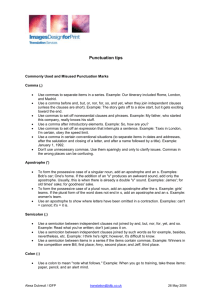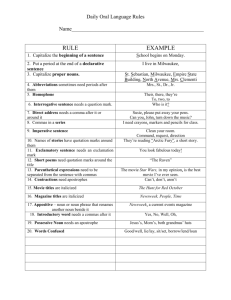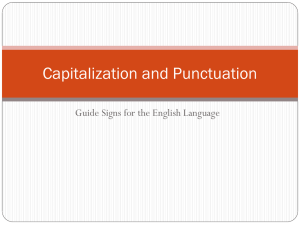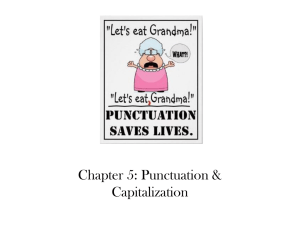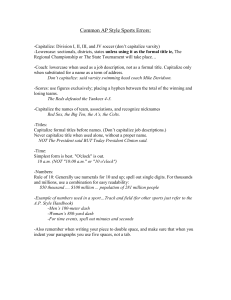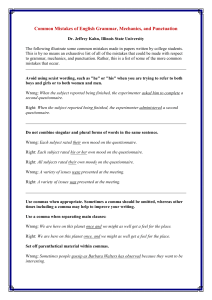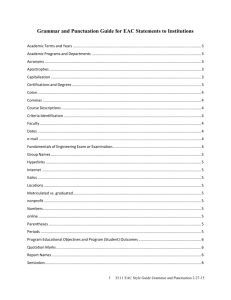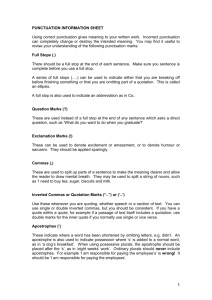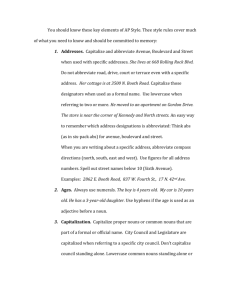Capitalization and Punctuation Rules
advertisement
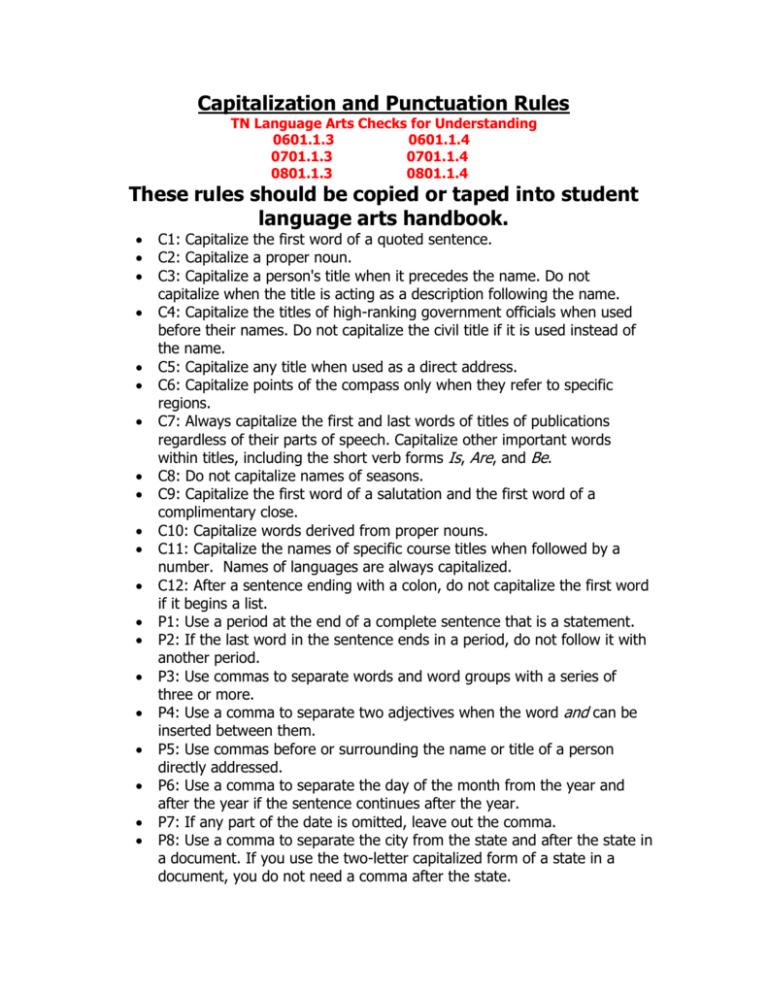
Capitalization and Punctuation Rules TN Language Arts Checks for Understanding 0601.1.3 0601.1.4 0701.1.3 0701.1.4 0801.1.3 0801.1.4 These rules should be copied or taped into student language arts handbook. C1: Capitalize the first word of a quoted sentence. C2: Capitalize a proper noun. C3: Capitalize a person's title when it precedes the name. Do not capitalize when the title is acting as a description following the name. C4: Capitalize the titles of high-ranking government officials when used before their names. Do not capitalize the civil title if it is used instead of the name. C5: Capitalize any title when used as a direct address. C6: Capitalize points of the compass only when they refer to specific regions. C7: Always capitalize the first and last words of titles of publications regardless of their parts of speech. Capitalize other important words within titles, including the short verb forms Is, Are, and Be. C8: Do not capitalize names of seasons. C9: Capitalize the first word of a salutation and the first word of a complimentary close. C10: Capitalize words derived from proper nouns. C11: Capitalize the names of specific course titles when followed by a number. Names of languages are always capitalized. C12: After a sentence ending with a colon, do not capitalize the first word if it begins a list. P1: Use a period at the end of a complete sentence that is a statement. P2: If the last word in the sentence ends in a period, do not follow it with another period. P3: Use commas to separate words and word groups with a series of three or more. P4: Use a comma to separate two adjectives when the word and can be inserted between them. P5: Use commas before or surrounding the name or title of a person directly addressed. P6: Use a comma to separate the day of the month from the year and after the year if the sentence continues after the year. P7: If any part of the date is omitted, leave out the comma. P8: Use a comma to separate the city from the state and after the state in a document. If you use the two-letter capitalized form of a state in a document, you do not need a comma after the state. P9: Use commas to surround degrees or titles used with names. Commas are no longer required around Jr. and Sr. Commas never set off II, III. P10: Use commas to set off expressions that interrupt sentence flow. P11: Use a comma after phrases of more than three words that begin a sentence. If the phrase has fewer than three words, the comma is optional. P12: Use a comma before a conjunction that joins two independent clauses. P13: Use commas to set off direct quotations. P14: Use a comma when beginning sentences with introductory words such as well, now, or yes. P15: Use commas surrounding words such as therefore and however. P16: Use a semicolon in place of a period to separate two sentences where the conjunction has been left out. P17: It is preferable to use a semicolon before introductory words such as namely, however, therefore, that is, i.e., for example, e.g., or for instance when they introduce a complete sentence. P18: Use the semicolon to separate units of a series when one or more of the units contain commas. P19: Use the semicolon between two sentences joined by a coordinating conjunction when one or more commas appear in the first sentence. P20: Use the colon after a complete sentence to introduce a list of items when introductory words such as namely, for example, or that is do not appear. P21: Use the colon to follow the salutation of a business letter even when addressing someone by his/her first name. Never use a semicolon after a salutation. A comma is used after the salutation for a friendly letter. P22: Periods and commas always go inside quotation marks, even inside single quotes. P23: The placement of question marks with quotes follows logic. If a question is in quotation marks, the question mark should be placed inside the quotation marks. P24: Use single quotation marks for quotes within quotes. P25: Use quotation marks to set off a direct quote. P26: Use the apostrophe with contractions. The apostrophe is always placed at the spot where the letter(s) has been removed. P27: Use the apostrophe to show possession. Place the apostrophe before the s to show singular possession. P28: Do not use an apostrophe for the plural of a name. P29: Never use an apostrophe with possessive pronouns: his, hers, its, theirs, ours, yours, whose. They already show possession so they do not require an apostrophe. P30: The only time an apostrophe is used for it's is when it is a contraction for it is or it has.

